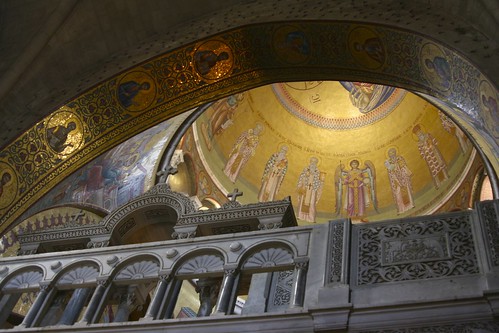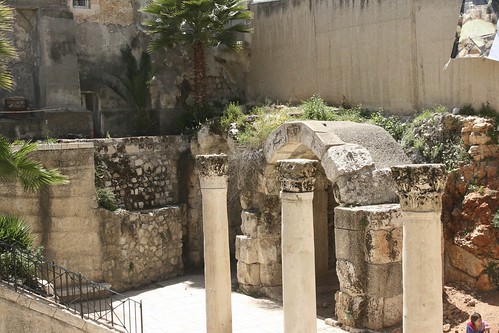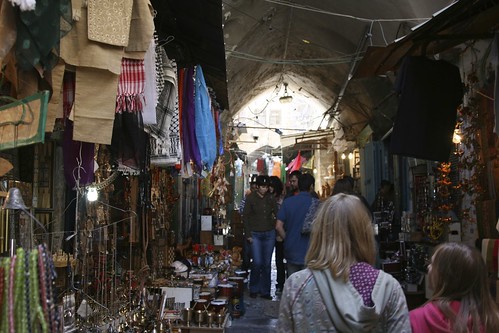The Epicenter of History
In Jerusalem’s Old City, Christian pilgrims visit the Church of the Holy Sepulchre, located on the site where the faithful believe Jesus was crucified, then resurrected.
Nearby, pious Jews gather at the Western Wall of Temple Mount, whose foundation, according to Jewish tradition, was built by King Solomon. Many Jews believe The Wall is near the spot God gathered the dust He used to create Adam.
A few hundred yards away is The Dome of the Rock, the oldest Islamic building in the world and the third holiest site in Islam. Muslims believe that from this spot Muhammad ascended to heaven on the back of his horse, before returning to earth to record his vision.
Is it possible to pack more historic, cultural and religious significance into an area less than a square mile?
I am not a particularly religious person, but my skin tingled as I walked the cobblestone streets of a city whose sites that have been fought over for centuries. A place that stands at the heart of so many of the great conflicts of human history.
It is impossible to visit Jerusalem’s Old City and not be moved.
In the Church of the Holy Sepulchre, I watched as pilgrims touched the stone they believe Jesus was laid on after he was taken down from the cross. A few steps away they entered the chamber believed to have been his tomb.
Seven Christian churches share custodial duties at the church – but throughout history there have been so many fights among the custodians that a Muslim family holds the key to the main entrance.
At the Western Wall (once referred to as the Wailing Wall), Jewish pilgrims stick scribbled notes to God in the cracks. According to the Torah, God rested His Divine Presence near this spot, and many Jews regard the Wall as a place to experience His Presence.
The Wall marks the western boundary of Temple Mount, the site of two Jewish Temples: the First Temple built by King Solomon, the Second Temple by King Herod. According to Jewish tradition, the Third Temple (and final) will be built here as well.
There is a tradition that says when water starts trickling through the stones of the Wall, it is a sign of the coming of the Jewish Messiah.
But it is The Dome of the Rock, a site holy to Muslims, Christians and Jews, that dominates the Old City skyline. The Dome marks an important point on Muhammad’s miraculous journey, known in Islamic tradition as the Isra and Mi’raj.
Muslims believe that Muhammad was visited in Mecca by the archangel Gabriel, who provided him with the winged horse Buraq, the traditional transportation of the prophets. Buraq then took Muhammad to the “farthest mosque,” believed to be the Noble Sanctuary (Temple Mount) in Jerusalem.
After arriving at the site of what today is The Dome of the Rock, Muhammad ascends to heaven and speaks to the earlier prophets: Abraham, Moses, and Jesus. Gabriel then takes him to Allah.
Allah instructs Muhammad that Muslims must pray fifty times a day. When Moses learns of Allah’s instructions, he urges Muhammad to go back and ask for a reduction – and finally it is reduced to praying five times a day.
Jews and Christians hold the site of The Dome of the Rock holy as well. It is considered to be the site of The Well of Souls – the spot where the souls of the dead will gather as they await the Last Judgment.
To spend a day in Jerusalem is to walk through history. Not just religious history, though there is plenty. It is, in fact, the epicenter of Western culture.
It would take several books to describe the importance of Jerusalem through the centuries. Consider for a moment The Crusades, the Ottoman Empire, World War I or the Six Day War. Jerusalem was central to each of these historic conflicts.
But on the day we visited, there was no conflict apparent. As we strolled through the Armenian Quarter, the Jewish Quarter, the Muslim Quarter and the Christian Quarter, we were greeted with smiles and words of welcome. And the city itself had seemed to find an uneasy balance of co-existence.
Perhaps there, at the heart of Jerusalem, lies our best hope for a future of peace.








3 comments
I like how Moses convinced Muhammad to negotiate with God on the prayer thing. It makes me wonder if there were originally a lot more commandments and Moses talked God down on that as well.
I totally agree Craig. It is amazing to walk the streets of Jerusalem. You feel that with everything Jerusalem has been through that a lasting peace is more than possible.
I thought you might be interested in learning about OUR Jewish traditions which embrace the real Christ. We are the Frankist Association of America. One of our members has a new book out:
http://www.amazon.com/Real-Messiah-Throne-Origins-Christianity/dp/1906787123/ref=sr_1_1?ie=UTF8&s=books&qid=1245892844&sr=8-1
These are our teachings passed on through generations. If you can’t afford the book you can see the website of one of our teachers – http://www.stephanhuller.blogspot.com.
Shalom
Beth El Jacob Frank